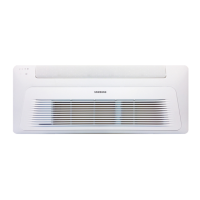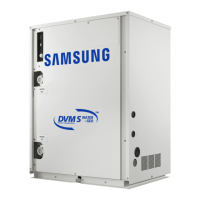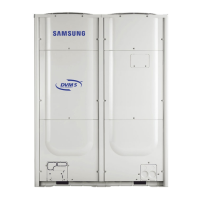14
Installation Procedure
English
Installation Procedure
5 Select the insulation of the refrigerant pipe.
࡛ Insulate the gas side and liquid side pipe, noting the insulation thickness that must differ according to the pipe size.
࡛ Standard: Less than an indoor temperature of 30°C, with humidity at 85%. If installing in a high humidity
environment, use one grade thicker insulator by referring to the table below. If installing in an unfavourable
environment, use thicker one.
࡛ The heat-resistance temperature of the insulator must be more than 120°C.
Pipe
Pipe size
(mm)
Insulation Type (Heating/Cooling)
Remarks
Standard
[30°C, 85%]
High humidity
[30°C, over 85%]
EPDM, NBR
Liquid
pipe
Ø6.35 to Ø9.52 9t
Internal temperature
is higher than 120°C
Ø12.7 to Ø50.80 13t
Gas pipe
Ø6.35 13t 19t
Ø9.52 to Ø25.40
19t
25t
Ø28.58 to Ø44.45 32t
Ø50.80 25t 38t
࡛ When installing insulation in the places and conditions
below, use the same insulation that is used for high
humidity conditions.
<Geological condition>
High humidity locations such as shorelines, hot springs,
lake or riversides, and ridges (when part of the building is
covered by earth and sand)
<Operation purpose condition>
Restaurant ceiling, sauna, swimming pool etc.
<Building construction condition>
Ceilings frequently exposed to moisture and cooling are
not covered. For example, pipes installed at a corridor of a
dormitory and studio or near an exit that opens and closes
frequently.
Places (where the pipes are installed) that are highly
humid due to a lack of ventilation.
࡛ Refrigerant pipe before EEV kit and MCU or without
EEV kit and MCU
ࣞ You can contact the gas side and liquid side pipes
but the pipes should not be pressed.
ࣞ When contacting the gas side and liquid side pipe,
use 1 grade thicker insulator.
࡛ Refrigerant pipe after EEV kit and MCU
ࣞ Install the gas side and liquid side pipes, leave
10mm of space.
ࣞ When contacting the gas side and liquid side pipe,
use 1 grade thicker insulator.

